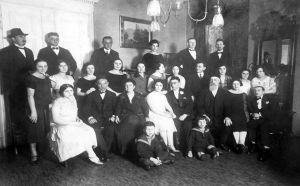Branches. Between the times – very close.
Jewish branches of life – among others: How a Stolperstein (“tripping stone”) in the East of Leipzig is making waves worldwide …
The history of people is always also the history of a country. Consequently, to understand our own history, we must also always know about that of our country. The life stories of Sofie Schneider and her family, like ours, are part of this.
This indispensability of confrontation as well as the antisemitism of the present caused the Women’s Cultural Centre Leipzig to initiate the laying of a Stolperstein for* Sofie Schneider* – a Leipzig painter of Jewish origin – in 2013. The Stolperstein in memory of Sophie was laid on 16 July 2013.
The results of the intensive research into the life of Sofie Schneider were very incomplete in 2013. Eight years later, in March 2020, a relative of Sofie Schneiders sent an email from South Africa to thank Frauenkultur Leipzig for laying the Stolperstein of her great-great-grand aunt.

I am sorry that I cannot communicate in German. I am a South African Jewish woman who visited Leipzig last year on my way to a conference in Hamburg. I discovered the Jewish records office (Israelitische Religionsgemeinde zu Leipzig) and they helped me find information about my great great aunt Sora Sophie Schneider who was an artist in Leipzig until she died in the holocaust. I visited her apartment Eisenbahnstr. 97. I looked for a Stopelsteine there but couldnt find it.
I wanted to organise one and just found out that your organisation did organise one for her in 2011. I want to thank you profoundly for remembering her and doing that. I also need help trying to find out if any of her art survived. I cannot find anything online but realise that not being able to speak German is a huge problem in searching online. I have two pieces of her art (a drawing and an etching) and my mother has one drawing. Can you possibly help in finding out if any of her art remains in Leipzig or in Germany?
Best
Ruth Morgan
This simple contact was the beginning of a development that was and is connected with extensive research of her Jewish family, which is branching out all over the world.
To make Sofie Schneider’s life, her work and her Jewish family history in Leipzig public – for us a possibility of not forgetting; for us and her large family a possibility of meeting, of getting to know each other – also in different references to Leipzig (city) history.
In the first documents we found in archives – the name Sora Sofie Schneider was written. That is why the first name Sora can also be read on the stone. Only through contact with the family in 2020 did we learn that Sora was never the name of Sofie Schneider.
Sora was the vaguely legible variant of Sara in an archive document. On 17 August 1938, the Nazi regime forced German Jews to adopt stigmatising first names: Men had to use “Israel” as their middle name, women “Sara”. This was another humiliating step on the path to disenfranchisement. The “Second Regulation for the Implementation of the Law on the Change of Family Names and First Names” came into force, supplemented one day later by the “Guidelines on the Use of First Names”. Consequently, the imposed first name is no longer mentioned on this website.
This website is a way to trace moments in the (life) journeys of Sofie Schneider and her family – with stories gathered by her siblings, their children and grandchildren… about their life and work in Leipzig, about their involuntary journeys away from this city. A piece of the congregational life of the Body Synagogue in Keilstraße becomes visible. And for the first time, Sophie Schneider’s “rediscovered” artistic works will be shown publicly.
The work on this website is kindly supported by Esther Jonas-Märtin, Rabbi, M.A., M.A., Chairperson Beth Etz Chaim. Lehrhaus-Gemeinschaft-Teilhabe e.V.
